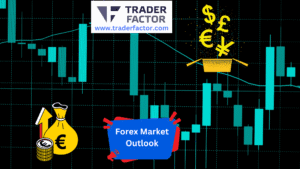Financial markets opened to notable turbulence this week, with the dollar’s recent weakness against global currencies causing ripples across multiple asset classes. Gold prices surged as uncertainty deepened, while the American stock market experienced a sharp selloff. Investors brace for key corporate earnings reports and crucial economic data, particularly PMI numbers and mounting U.S.-China trade tensions. Amid heightened volatility, markets are looking for clear indicators as geopolitical dynamics and domestic policies dominate headlines.
- Gold surged past $3,400 as the dollar weakened.
- EUR/USD and GBP/USD rose; USD/JPY hit seven-month lows.
- U.S. stocks fell sharply (Nasdaq -2.6%, S&P 500 -2.4%, Dow -2.5%).
- Tesla faces delays; Alphabet focuses on cloud growth.
- PMI reports this week are key for U.S. outlook.
- U.S.-China trade tensions escalate with Beijing’s warnings.
Table of Contents
ToggleDollar Performance
Gold Hits Record Highs Amid Dollar Concerns
Gold prices soared beyond $3,400 per ounce, achieving an all-time high as investors seek refuge in this traditional safe-haven asset. Weakened confidence in the greenback, driven by President Trump’s combative remarks against Federal Reserve Chair Jerome Powell, has amplified gold’s appeal. Technical analysis shows strong momentum, with gold finding support around $3,380 and resistance emerging at the $3,500 mark. Analysts caution that a breach beyond this could signal continued bullishness but urge vigilance due to upcoming economic uncertainties.

The ongoing push-and-pull between inflationary prospects and lower dollar yields remains a key dynamic supporting gold. Central bank policies play a pivotal role here, and with markets pricing in potential rate cuts, the upward movement in gold prices seems sustainable in the short term. However, a sudden correction remains possible should U.S. economic data outperform expectations or the dollar regain footing in the coming sessions.
EUR/USD Rides Broad Dollar Weakness
EUR/USD has sustained its upward momentum, trading above the 1.1500 level as it capitalizes on the dollar’s broader fragility. European economic stability, coupled with weaker-than-expected U.S. performance, has bolstered euro gains. Traders eyeing the pair anticipate immediate resistance near 1.1650, with initial support positioned at 1.1520.

The pair’s trajectory could shift based on the upcoming PMI data, which may either confirm eurozone resilience or expose vulnerabilities. Technical indicators remain optimistic, with upward momentum sustained. However, any adverse developments in European macro data may temper gains, particularly as the ECB continues monitoring inflation risks across member states.
GBP/USD Extends Seasonal Gains
The pound is capitalizing on its strong April seasonal trend, pushing past 1.3100 against the dollar. Favorable sentiment and historical precedents lend continued optimism to GBP/USD traders. Key technical evaluations place immediate resistance at 1.3160, while support is assessed at 1.3010.

Beyond technical indicators, long-term views appear cautiously optimistic as the U.K. stabilizes its financial policies. Still, potential labor market disruptions or sharp inflation spikes pose risks, potentially capping upside momentum over the next trading cycle.
AUD/USD Boosted by Trade Sentiment
The Australian dollar has strengthened significantly, now trading above the 0.6400 mark. Renewed optimism around global trade discussions and the U.S. Fed’s contested independence have reinforced confidence in the Aussie. Analysts note immediate resistance at 0.6430 and critical support zones forming around 0.6350.

Yet, the geopolitical landscape weighs heavily on projections, with U.S.-China tensions looming large. Current sentiments hint that extended trade optimism or dovish Fed actions would buoy the AUD further. However, downside risks include sharp volatility if global equities falter amidst deteriorating trade negotiations.
USD/JPY Tests Crucial Support Levels
The U.S. dollar slipped to seven-month lows against the yen, hovering near the 140.00 level. Widespread risk aversion stemming from hawkish Japanese monetary policy and Fed-related uncertainties has placed USD/JPY under continued pressure. Technical support sits firmly at 139.50, with resistance at 141.00.

Analysts observe that yen strength correlates closely with global economic fears, which drive investors toward safer assets. For now, the Japanese government’s lack of intervention provides breathing space for yen bulls, while the dollar’s position appears increasingly precarious given domestic turbulence.
Stock Market Overview
Major U.S. indices began the trading week on a sour note as geopolitical and domestic uncertainties weighed heavily on sentiment. Monday saw steep declines amid mounting concerns over Federal Reserve independence and repercussions of prolonged trade wars.
Nasdaq Faces Losses Led by Tech Sell-Off
The Nasdaq posted a sharp 2.6% decline at the start of the week, driven by substantial sell-offs in tech-heavy equities. Semiconductors and AI stocks faced intensified scrutiny due to tightened international trade conditions. Analysts note a year-to-date plunge of 18%, further highlighting the vulnerability of growth stocks under current market conditions.

Tech giants such as Nvidia and Alphabet are closely watched this earnings season. A mixture of cautious optimism and guarded skepticism permeates investor sentiment, especially as sector-specific headwinds, like trade barriers, weigh heavily on valuations.
S&P 500 Drops Amid Widespread Sell-Offs
The S&P 500 fell by 2.4% on Monday, marking its weakest opening since February. The index’s decline of over 16% this year underscores the challenges facing broader markets. Consumer discretionary sectors led the losses as inflationary pressures deter spending among households.

Institutional investors remain largely risk-averse, waiting for more clarity regarding PMI figures and the Fed’s long-term stance. Meanwhile, energy and material stocks show some resilience, driven by commodity price fluctuations amid supply chain disruptions from the ongoing tariff battles.
Dow Jones Sees Industrial Weakness
The Dow Jones shed 2.5%, weighed down by struggling industrials and financials. The uncertainty caused by U.S.-China trade frictions continues to impact manufacturing-heavy companies that form the backbone of the Dow’s composition. Reports suggest that near-term headwinds will persist unless tangible progress in trade talks materializes.

Despite Monday’s losses, analysts view upcoming earnings reports as crucial for gauging the health of U.S. corporations. The Dow may see relief if industrial bellwethers like Boeing report earnings that exceed muted expectations.
Earnings Season Highlights
Tesla Faces Production Setbacks
Tesla begins the week under distress as setbacks to its Model Y production timeline worry investors. Shares dropped 5.8% Monday, reflecting concerns that delays could strain quarterly revenue. Despite holding market dominance in the EV space, Tesla continues to battle rising materials costs and geopolitical risks in sourcing batteries.
However, early indicators suggest Tesla may counteract these impacts by expanding its market share through Europe and Asia. Still, analysts reiterate caution, emphasizing that supply chain dynamics will play a pivotal role in the company’s trajectory this year.
Alphabet Eyes Stable Revenue Amidst Market Volatility
Alphabet Inc., another tech heavyweight, enters earnings season with projections of steady revenue growth. Obviously, Google is the main search engine hosting billions of sites such as AAMAX and others. While subdued advertising growth weighs on outlooks, several analysts anticipate a stronger performance for its cloud service division.
Alphabet’s ability to diversify its business and maintain strong operational margins positions the firm favorably, even in an otherwise volatile tech landscape. Investor attention will remain sharp on any guidance updates regarding AI developments and competitive shifts in the search engine market.
Industrial Firms Brace for Challenges
Companies like Boeing and Lockheed Martin have faced heightened scrutiny amidst geopolitical turmoil and supply chain challenges. While Boeing’s aircraft deliveries show signs of stabilization, risks tied to global trade restrictions weigh heavily on market sentiment.
Lockheed Martin finds itself navigating similarly murky waters as the defense contractor balances soaring demand from NATO allies against rising input costs. Analysts urge investors to monitor these companies closely, as their comments may set the tone for broader investor confidence in industrial equities.
Key Economic Events
PMI Reports in Focus
Flash PMI numbers set to release mid-week are expected to provide clarity on U.S. economic momentum. Manufacturing and Services indices serve as leading indicators of GDP trajectory, prompting analysts to closely scrutinize the data release.
Early forecasts suggest potential stagnation in manufacturing activity as labor market difficulties persist. A downturn would add more pressure on the beleaguered dollar, further magnifying its ongoing weakness. However, robust numbers could reignite Fed confidence, alleviating some of the broader anxieties surrounding upcoming policy meetings.
U.S.-China Trade Tensions Escalate
The sustained trade war with China remains headline news. Beijing’s recent warnings to trade partners not to lean toward the U.S. have further exacerbated tensions. Trade imbalances and tariff retaliations weigh heavily on global supply chains, pushing costs higher for multinationals reliant on Chinese goods.
Analysts argue that prolonged indecision could further constrict corporate earnings, particularly among U.S. exporters. Markets are on edge as investors await any progress in the deadlock, but skepticism abounds given the entrenched geopolitical positions of both nations.
Conclusion
This week paints a challenging picture for global markets. From dollar instability and poor equity performance to earnings surprises and PMI uncertainties, investors face an array of hurdles. While opportunities exist for tactical plays, the broader narrative remains one of caution as economic and political uncertainties cloud the investment horizon.
Disclaimer:
All information has been prepared by TraderFactor or partners. The information does not contain a record of TraderFactor or partner’s prices or an offer of or solicitation for a transaction in any financial instrument. No representation or warranty is given as to the accuracy or completeness of this information. Any material provided does not have regard to the specific investment objective and financial situation of any person who may read it. Past performance is not a reliable indicator of future performance.

















